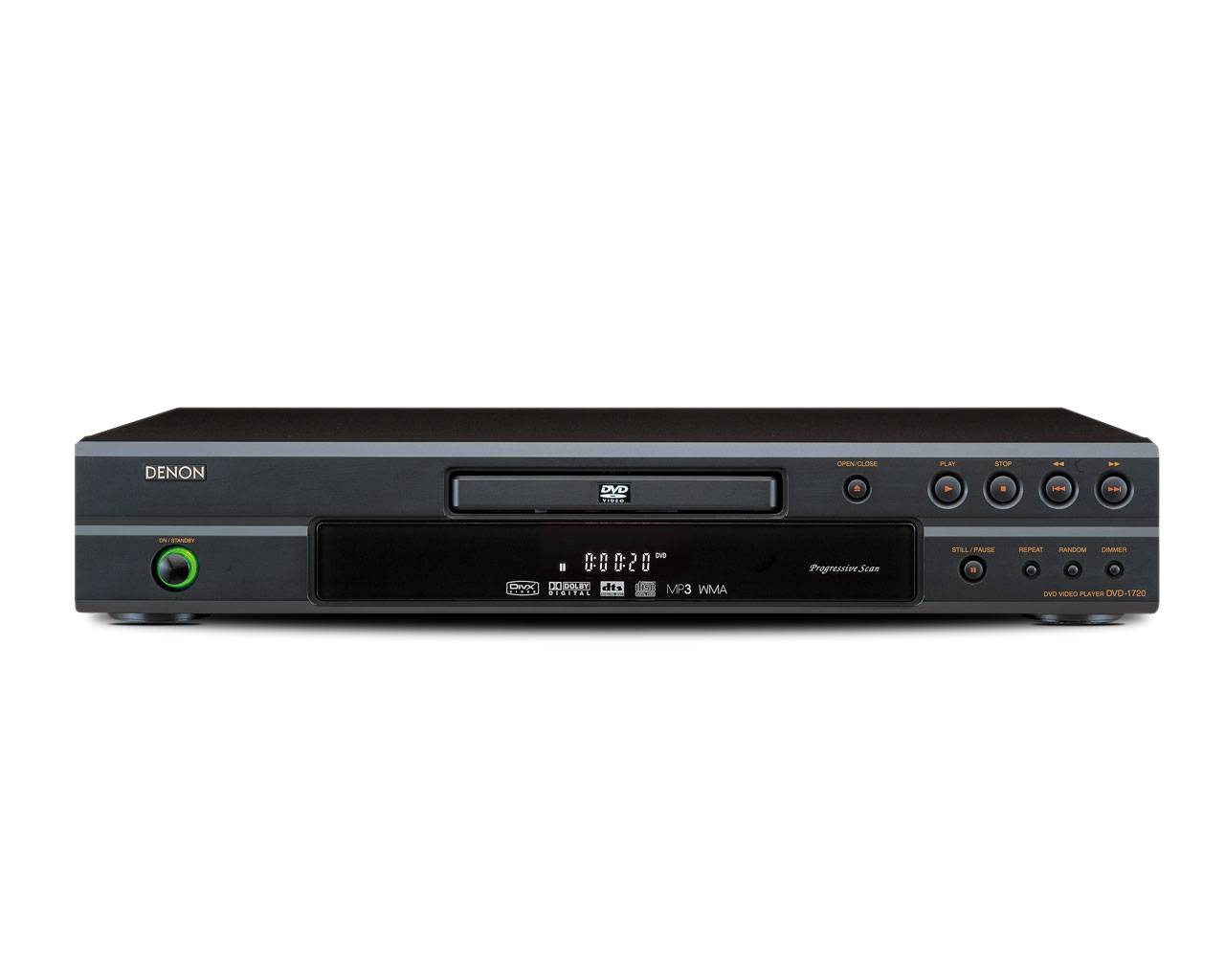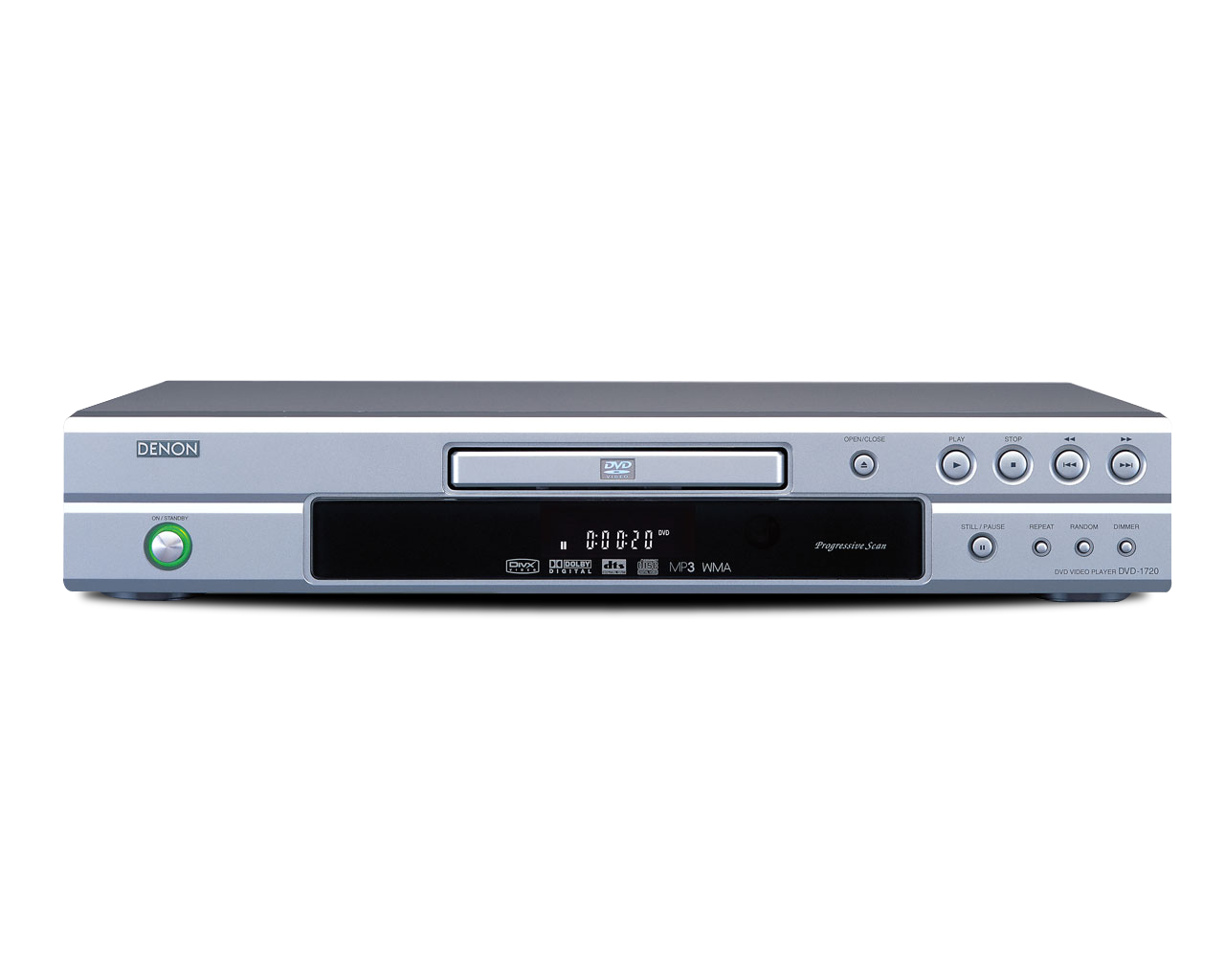Features - DVD-1720
- Progressive Scan (PAL/NTSC* output)
- 108Mhz High Resolution Audio D/A Converter
- 24-Bit, 192-kHz High Resolution Audio D/A Converters
- DVD-R/RW (DVD-Video Mode) Playback
- DVD+R/RW Playback
- Plays DivX Video-Playback Video content
- CD-R/RW (MP3/Windows Media Audio/JPEG/Kodak Picture CD)Playback
- Color Component Video Output
- Icon Based On-Screen Display
- PCM, Dolby Digital and DTS Digital Output
- VSS (Virtual Surround System)
- 2MB Buffer
Downloads - DVD-1720
TECHNOLOGY- DVD-1720
-
 DivX Video-Playback
DivX Video-PlaybackDivX is an advanced digital media format. DivX lets you play, create and share digital video by turning large video files into much more streamlined DivX files. Using a DivX codec (short for compressor/decompressor) to compress the video to a convenient size without losing any noticeable quality and play those videos back on almost any device. For example, the DivX codec can compress an MPEG-2/DVD file to nearly one-tenth its original size.
-
 Dolby Digital-Decoder
Dolby Digital-DecoderDolby Digital is the multi-channel digital signal format developed by Dolby Laboratories. Dolby Digital consists of up to "5.1" channels - front left, front right, center, surround left, surround right and an additional channel exclusively reserved for additional deep bass sound effects (the Low Frequency Effects - LFE - channel, also called the ".1" channel, containing bass frequencies of up to 120Hz).
Unlike the analog Dolby Pro Logic format, Dolby Digital's main channels can all contain full range sound information, from the lowest bass, up to the highest frequencies - 22kHz. The signals within each channel are distinct from the others, allowing pinpoint sound imaging and Dolby Digital offers tremendous dynamic range from the most powerful sound effects to the quietest, softest sounds, free from noise and distortion. -
 DVD Video
DVD VideoA single-sided, single-layer Digital Versatile Disc (DVD) Video, holds approximately 133 minutes of full-motion video using MPEG-2 compression. The visual quality is that of a LaserDisc, which is superior to a VHS tape. The 133 minutes is an approximate number, because compression is not fixed, but is based upon the amount of motion taking place.
DVD-Video discs can be recorded on both sides, and two layers per side can be used, thus up to four two-hour movies can be contained on a single volume. DVD-Video supports Dolby Digital surround sound, which provides five discrete channels of CD-quality audio plus a subwoofer (5.1 channel). -
 Kodak Picture CD-compatible
Kodak Picture CD-compatibleDVD players that have the Kodak picture CD compatible logo, have been tested and certified by Kodak to ensure that an enjoyable viewing experience is provided. You can view your picture CD on these DVD players.
-
 MP3 Playback
MP3 PlaybackA compressed audio format that is popular for downloading across the internet. Files may be recorded on CD-R or CD-RW media for playback in compatible DVD players, audio CD players, and CD-ROM drives. Files are usually named as "*.mp3". Sound quality varies as a function of the recording/encoding bit rate. For a high fidelity home audio system, its recommended to use MP3s encoded at no less than 256 kbps data rate. Anything less would mean too much compression was used at the cost of sound fidelity. See also WMA files compatibility with DVD and CD players.
-
 Progressive Scan
Progressive ScanProgressive scan works in the same manner as your computer monitor. It writes one full frame of video from left to right across the screen every 1/60 of a second. Since the entire image is drawn at one time--as opposed to an interlaced image where the even lines are drawn first, followed by the odd lines--a progressively scanned video image looks more stable than an interlaced one. Progressive scan also introduces fewer motion artifacts, such as jagged diagonal lines and movement in fine detail, into the picture.
Progressive-scan Denon DVD players will work with digital HDTVs and are not compatible with older analog sets, due to their higher horizontal-scanning frequency of 31.5kHz. One big feature that will be in any progressive-scan DVD player is 3:2 pull-down circuitry. This helps to differentiate between the 24fps (frames per second) frame rate of film and the 30fps frame rate of video. Bassically it smoothes out the picture and virtually eliminates jaggie artifacts.
Progressive-scan DVD players deliver much better pictures as they can read extra data tags on DVDs and the players can process the image digitally before they output the video signal in analog form. (Almost all home-theater DVD players can output only an analog signal.) If you feed an interlaced DVD signal to a digital HDTV, the TV's line doubler must convert the signal to digital before processing the image, and the TV doesn't have access to the extra data stored on the DVD. For this reason, a progressive-scan DVD player can deliver a sharper, cleaner picture. -
 WMA files compatibility with DVD and CD players.
WMA files compatibility with DVD and CD players.Windows Media Audio (WMA) is a proprietary compressed audio file format developed by Microsoft. It was initially a competitor to the MP3 format, but with the introduction of Apple's iTunes Music Store, it has positioned itself as a competitor to the Advanced Audio Coding format used by Apple. It is part of the Windows Media framework.
A WMA file is almost always encapsulated in an Advanced Systems Format (ASF) file. The resulting file may have the filename suffix "wma" or "asf" with the "wma" suffix being used only if the file is strictly audio. The ASF file format specifies how metadata about the file is to be encoded, akin to the ID3 tags used by MP3 files.
Files in this format are mainly played using Windows Media Player, Winamp (with certain limitations, DSP plugin support and DirectSound output is disabled using the default WMA plugin) and many other alternative media players.
The most current version of the format is Windows Media Audio 10 which includes specific codecs for lossless, multi-channel surround sound and voice encoding in addition to the main lossy codec. Both constant and variable bit rate encoding are supported.
Denon DVD players can play CDR's or CDRW's with WMA and MP3 files burnt on them as long as they have been burnt using a slow speed, recommended x4 speed.
BE THE FIRST TO KNOW
You want to receive news about our products or upcoming promotions? Just sign up to our newsletter now.
Privacy policy







